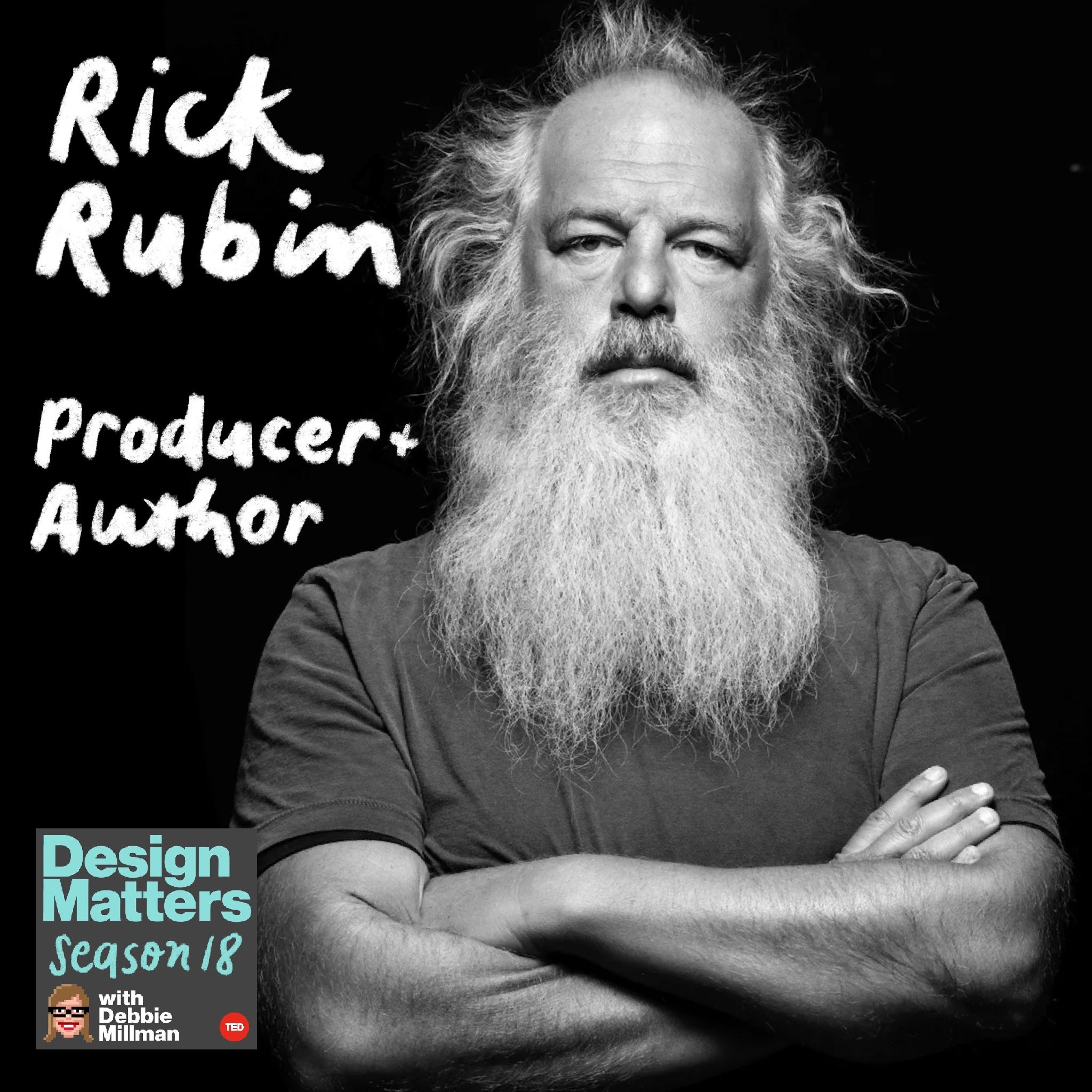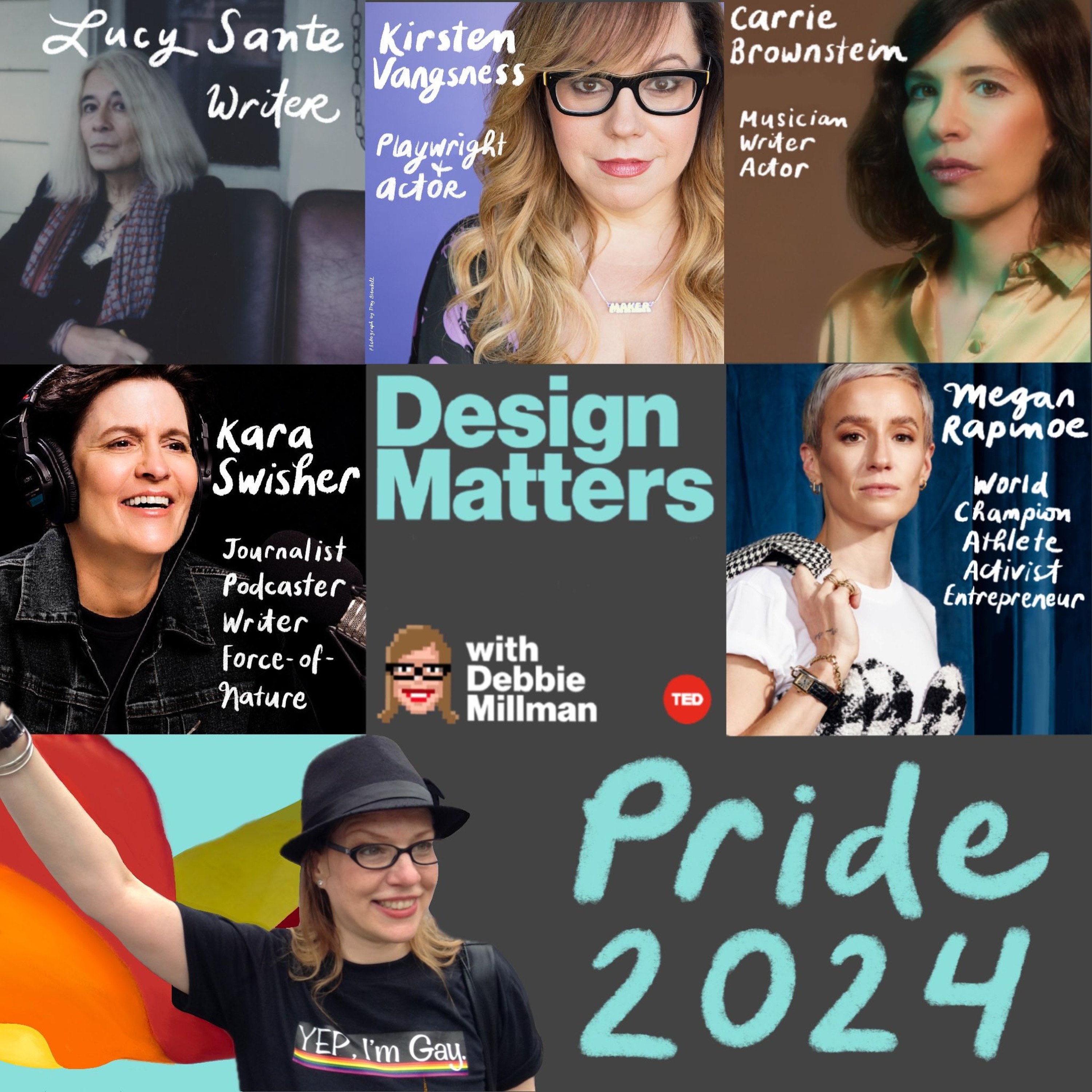Brooke Hopper
Digest
This episode of Design Matters with Debbie Milman delves into the complex and evolving relationship between creativity and AI. The episode features an interview with Brook Hopper, Adobe's principal designer for machine intelligence and new technology. Hopper provides insights into the impact of human bias on AI, highlighting how the data used to train AI systems can perpetuate existing societal biases. She emphasizes the importance of mitigating bias and ensuring that AI is trained on licensed and ethically sourced data. Hopper also explores the potential for AI to enhance or compete with human imagination, arguing that AI can serve as a powerful tool for generating ideas and exploring new creative directions. She emphasizes the importance of human control and oversight in AI-assisted creativity, ensuring that AI remains a tool for human expression rather than a replacement for it. The episode concludes with a discussion about the future of AI in design and creativity, with Hopper expressing optimism about the potential for AI to expand creative possibilities and make art more accessible and integrated into our lives.
Outlines

Progressive Advertisement
This Chapter is an advertisement for Progressive insurance, highlighting the potential savings for drivers who switch to Progressive.

Apple Card Advertisement
This Chapter is an advertisement for Apple Card, emphasizing its features such as daily cashback, no fees, and availability in the Wallet app on iPhone.

Introduction and Brook Hopper's Background
This Chapter introduces the episode's guest, Brook Hopper, principal designer for machine intelligence and new technology at Adobe. It explores Hopper's early artistic inspirations, her journey into design, and her current role at Adobe.

Defining AI, Machine Learning, and Generative AI
This Chapter clarifies the distinctions between artificial intelligence (AI), machine learning, and generative AI, providing examples of each. Hopper emphasizes that AI is not a new concept and that we use it in various aspects of our lives without realizing it.

Human Bias in AI
This Chapter explores the impact of human bias on AI, acknowledging that AI systems inherit biases from the data they are trained on. Hopper discusses the challenges of mitigating bias and ensuring fairness in AI training data.

Protecting Artists' Rights in AI Training
This Chapter addresses the ethical concerns surrounding the use of copyrighted content to train AI models. Hopper advocates for training AI on licensed data and protecting the rights of artists whose work is used without permission.

Enforcing Ethical AI Practices
This Chapter discusses the challenges of enforcing ethical AI practices, including the use of non-copyrighted data and the protection of artists' rights. Hopper highlights initiatives like Adobe's Content Authenticity Initiative and the need for both legal and societal measures to ensure responsible AI development.

Transparency and Data Privacy in AI
This Chapter explores the importance of transparency and data privacy in AI. Hopper discusses the need for companies to be transparent about how they use user data and for individuals to be educated about data privacy and deep fakes.

Spotting Deep Fakes
This Chapter addresses the challenge of identifying deep fakes, acknowledging that the technology used to create them is also used for creative purposes. Hopper emphasizes the need for behind-the-scenes information and metadata to help distinguish genuine content from deep fakes.

Protecting Personal Privacy in the Age of AI
This Chapter discusses the legal and ethical implications of AI-generated deep fakes, particularly in relation to personal privacy. Hopper highlights the Fair Act, which aims to protect individuals from the misuse of their likeness, and the emerging issue of image abuse.

Transparency in AI Decision-Making
This Chapter emphasizes the importance of transparency in AI decision-making. Hopper advocates for embedding information about AI usage in content created with AI tools, ensuring that users are aware of the role of AI in the creative process.

AI-First Design Products
This Chapter explores the prevalence of AI in design tools and products. Hopper discusses examples like Photoshop's Content Aware Fill and Figma's AI-driven features, highlighting how AI has become an integral part of the creative process.

AI and Human Creativity
This Chapter examines the relationship between AI and human creativity. Hopper argues that AI can be a valuable tool for generating ideas and exploring new creative directions, but that human creativity remains essential for perspective, emotion, and rule-breaking.

AI and Rule-Breaking
This Chapter explores the limitations of AI in terms of rule-breaking and originality. Hopper acknowledges that AI can be trained to break rules, but that its rule-breaking is still based on patterns and prompts, lacking the spontaneity and serendipity of human creativity.

AI in Education
This Chapter discusses the challenges of ensuring academic integrity in the age of AI. Hopper suggests that educators should focus on teaching students how to use AI responsibly and critically, rather than trying to prevent its use altogether.

AI in Graduate Education
This Chapter shares personal experiences from Debbie Milman, who runs a graduate program at the School of Visual Arts, about how students are using AI for research and creative purposes. Milman discusses the potential of AI to generate new ideas and perspectives, but also the importance of human voice and originality in creative work.

Identifying AI-Generated Content
This Chapter explores the challenges of identifying AI-generated content. Hopper highlights Adobe's Content Authenticity Initiative and Content Credential website, which aim to provide tools for verifying the authenticity of digital content.

Protecting Writers' Rights in AI Training
This Chapter addresses the concerns surrounding the use of writers' work to train AI models. Hopper discusses the need for writers to be able to opt out of AI training and for companies to respect their rights.

Contemporary Artists Using AI
This Chapter highlights contemporary artists who are using AI in innovative ways, including Pum Lefibior of Design Army and Marion Banshees. Hopper discusses how these artists are pushing the boundaries of AI and exploring its potential for creative expression.

AI and Equity in Design
This Chapter explores the potential of AI to address issues of equity in design. Hopper discusses a project she is working on with furniture designer Norman Teague, who is using AI to reimagine iconic furniture designs from the perspective of designers of color.

AI and Imagination
This Chapter examines the relationship between AI and human imagination. Hopper argues that AI can enhance imagination by providing unexpected results and sparking new creative directions, but that it cannot fully replicate the complexity and originality of human imagination.

Originality in AI-Enhanced Creativity
This Chapter explores the challenge of determining originality in AI-enhanced creativity. Hopper acknowledges that it is difficult to assess whether an AI-generated idea is truly original, emphasizing the importance of intent and the human element in the creative process.

AI as a Tool for Ideation
This Chapter discusses the role of AI in the ideation phase of the creative process. Hopper highlights the potential of AI to generate a wide range of variations and ideas, allowing designers and artists to explore multiple creative directions.

Prompt Engineering
This Chapter explores the concept of prompt engineering, the art of crafting effective prompts for AI systems. Hopper discusses the evolution of prompt engineering and the shift towards more visual and intuitive methods for interacting with AI.

AI and Job Displacement
This Chapter addresses the concerns about job displacement due to AI. Hopper acknowledges that AI may eliminate some jobs, but argues that it also creates new opportunities and that creatives will need to adapt and embrace new technologies.

Human Insecurity and Change
This Chapter explores the human tendency to feel insecure about change and new technologies. Hopper suggests that this insecurity is a natural part of being human and that we should embrace the potential for new technologies to create new opportunities and experiences.

The Future of AI in Creativity
This Chapter explores the potential for AI to expand creative possibilities in the future. Hopper envisions a world where AI allows creatives to work in more mediums and media, making creative expression more accessible and integrated into our lives.

AI and Sentience
This Chapter discusses the limitations of AI in terms of sentience and imagination. Hopper argues that AI cannot truly replicate human imagination, as its creativity is based on the data it has been trained on.

The Battle Between Artists and AI
This Chapter explores the relationship between artists and AI. Hopper emphasizes that human creativity is essential for emotion, perspective, and rule-breaking, and that AI can serve as a tool for human expression rather than a replacement for it.

AI and Data Falsification
This Chapter discusses the potential for AI to falsify data. Hopper acknowledges that generative AI can produce inaccurate or misleading information, emphasizing the need for critical thinking and verification when using AI-generated content.

The Future of AI
This Chapter explores the potential for AI in the next 10 and 100 years. Hopper envisions a future where AI enhances creativity, fosters immersive experiences, and makes art more accessible and integrated into our lives.
Keywords
Artificial Intelligence (AI)
Artificial intelligence (AI) refers to the simulation of human intelligence processes by computer systems. These processes include learning (the acquisition of information and rules for using the information), reasoning (using rules to reach approximate or definite conclusions), and self-correction. AI applications are used in various fields, including healthcare, finance, transportation, and entertainment.
Machine Learning
Machine learning (ML) is a subset of AI that focuses on the development of computer systems that can learn from data without explicit programming. ML algorithms are trained on large datasets to identify patterns and make predictions. Common ML techniques include supervised learning, unsupervised learning, and reinforcement learning.
Generative AI
Generative AI is a type of AI that focuses on creating new content, such as text, images, audio, and video. Generative AI models are trained on massive datasets and can generate realistic and creative outputs based on user prompts. Examples of generative AI models include DALL-E 2, Stable Diffusion, and ChatGPT.
Human Bias
Human bias refers to systematic errors in thinking that can influence our judgments and decisions. These biases can be based on our personal experiences, beliefs, and cultural background. In the context of AI, human bias can be reflected in the data used to train AI systems, leading to biased outputs and perpetuating existing societal inequalities.
Deep Fakes
Deep fakes are synthetic media, such as videos or images, that are created using AI to convincingly portray a person doing or saying something they did not actually do. Deep fakes can be used for malicious purposes, such as spreading misinformation or damaging reputations. They raise concerns about the authenticity of digital content and the potential for misuse.
Prompt Engineering
Prompt engineering is the art of crafting effective prompts for AI systems, particularly generative AI models. Effective prompts provide clear instructions and context to guide the AI in generating desired outputs. Prompt engineering requires understanding the capabilities and limitations of the AI model and using language that is both specific and creative.
Content Authenticity Initiative
The Content Authenticity Initiative (CAI) is a collaborative effort led by Adobe to address the growing problem of digital content manipulation. CAI aims to create a system for verifying the authenticity of digital content, including images, videos, and audio. This initiative involves embedding metadata into content to track its origin and modifications, helping to combat the spread of misinformation and deep fakes.
Adobe Firefly
Adobe Firefly is a family of generative AI tools developed by Adobe. Firefly allows users to create and edit images, videos, and other content using AI-powered features. Adobe Firefly is designed to be user-friendly and accessible to a wide range of creatives, providing tools for generating ideas, exploring new creative directions, and enhancing existing content.
South by Southwest (SXSW)
South by Southwest (SXSW) is an annual festival and conference held in Austin, Texas, that focuses on the convergence of technology, film, music, and interactive media. SXSW is known for its diverse programming, which includes keynote speeches, panel discussions, workshops, and networking events. It attracts a global audience of innovators, entrepreneurs, artists, and industry professionals.
School of Visual Arts (SVA)
The School of Visual Arts (SVA) is a private college of art and design located in New York City. SVA is known for its rigorous academic programs, its focus on contemporary art and design practices, and its strong alumni network. SVA offers a wide range of undergraduate and graduate programs in fields such as graphic design, illustration, photography, film, and animation.
Q&A
What is the difference between artificial intelligence (AI), machine learning, and generative AI?
AI is a broad term encompassing computer systems that simulate human intelligence processes. Machine learning is a subset of AI that focuses on systems learning from data without explicit programming. Generative AI is a smaller subset of machine learning that focuses on creating new content, such as images or text.
How has human bias impacted AI?
AI systems inherit biases from the data they are trained on, which can perpetuate existing societal biases. This can lead to biased outputs and perpetuate existing societal inequalities.
How can we protect artists' rights in AI training?
We need to ensure that AI models are trained on licensed data and that artists' work is not used without their permission. Companies should respect artists' rights and provide mechanisms for opting out of AI training.
How can we ensure transparency in AI decision-making?
We need to embed information about AI usage in content created with AI tools, ensuring that users are aware of the role of AI in the creative process.
How does AI enhance or compete with human imagination?
AI can enhance imagination by providing unexpected results and sparking new creative directions. However, it cannot fully replicate the complexity and originality of human imagination.
What are some contemporary artists using AI in interesting ways?
Pum Lefibior of Design Army and Marion Banshees are two artists who are pushing the boundaries of AI and exploring its potential for creative expression.
How can we ensure that AI-enhanced imagination is actually original?
It is difficult to determine whether an AI-generated idea is truly original. The importance of intent and the human element in the creative process are crucial.
How do you become a prompt engineer?
Prompt engineering involves crafting effective prompts for AI systems, providing clear instructions and context to guide the AI in generating desired outputs. It requires understanding the capabilities and limitations of the AI model and using language that is both specific and creative.
Are you worried about AI eliminating jobs?
While AI may eliminate some jobs, it also creates new opportunities. Creatives will need to adapt and embrace new technologies to thrive in the evolving creative landscape.
What is the potential for AI in the future of creativity?
AI has the potential to expand creative possibilities, allowing creatives to work in more mediums and media, making creative expression more accessible and integrated into our lives.
























